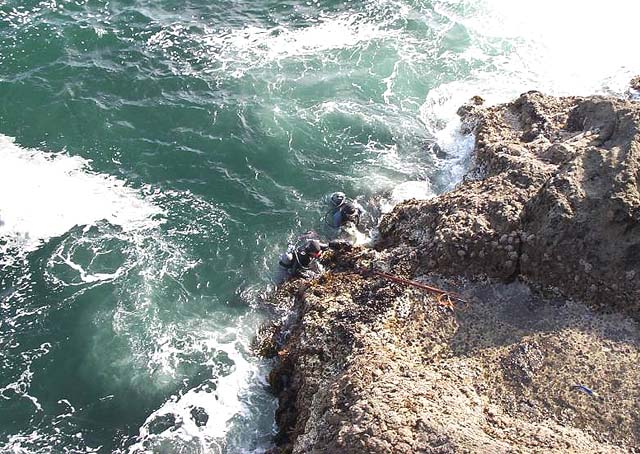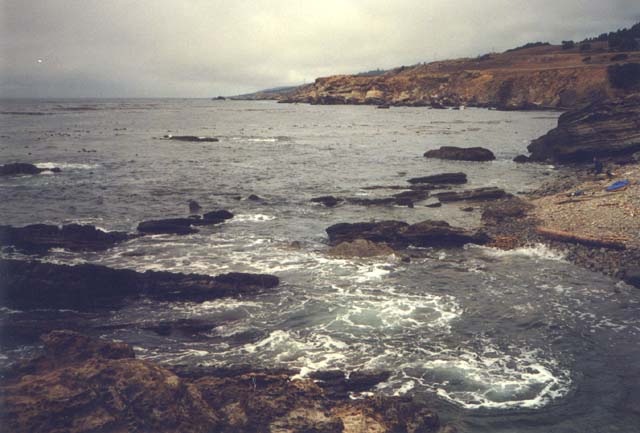CopyRight @ 1997
On the Northern California Coast is basically unlimited area of excellent
diving. The conditions tend to be quite challenging and access can be extremely
difficult. Still, because of the incredible beauty of the area in and out of
the water, many divers consider this to be their favorite destination. In
tropical waters, corals may be rather drab or they may be quite beautiful.
The reef fish are always spectacularly colored. On the California coast,
especially in the north, the algae provide a beautiful, fascinating lush
playground with interesting and colorful invertebrate life on every surface and
in every crack. The kelps are not as fragile or slow growing as corals. Indeed,
they are quite tough. Most algae grow to less than 2 feet off the bottom, but
there are also huge kelps that make dimly lit underwater forests alive with a
wide variety of local fish. Since wave and surge action rubs the large kelps
against the rocks, even in the thickest kelp there are usually clear paths in it
that a diver can swim through if they travel right along the bottom or along
rock edges. If there are no giant kelps to shade the bottom, the smaller algae
can grow riotously thick on the bottom. Some divers that were following me,
said that I reached the bottom and just kept going. Really, I had just gone into
the clear areas under the bottom growth. The further you can get under cover, the
more exotic bottom life you will see like crabs, shrimps, snails, abalone,
nudibranchs and colorful anemones. It makes for some of the most enjoyable
diving that a person can do. The bottom is so lush that it makes most other land
and water environments look barren. ... It must be like what an ant sees when
crossing a lawn...

One of the most popular activities on the North Coast is taking abalone. It
is fun and as challenging as you want to make it. It cannot be done with tanks
and so North Coast divers often become excellent skin divers. The minimum size
limit for a Red Abalone is 7 inches, but some divers carry a 9 or even 10 inch
measure, partly to insure that they take only the bigger ones, but mostly to
present maximum challenge to their diving.
I like abalone diving because of the challenge of the hunt, but more because
it forces you dive in a natural way. You are very subject to the waves, currents
and the terrain and so develop a heightened feel for the ocean you are diving
in. You are always looking for the remote untouched spot where some big toad
abalone may still lie unnoticed by previous divers. In ways, it is like bicycling
verses driving a car. You are going to get a much better look at where you are
than on scuba and may go where you normally wouldn't. The hunting brings out
natural instincts that heighten your perceptions and awareness of your surroundings.
First off when abalone diving is the question of how do you get an
abalone from rock to bag. How to cook them is in the
recipe page.
Whether you are a good free diver or have never taken game, the question of
how to get an abalone is still an unknown until you do it. Abalone generally
move quite slowly, though it is reported that they can go around 10 meters a
minute in sand and about 1/2 that on rock. (Jaques Cousteau) I have never seen
one move more than a few inches at a time. One did outrun me and went down a
hole once, when I was trying to show it to my sister. Anyhow, don't worry
about speed, worry about precision.
There are two facets to this. First is to find the abalone and the second is to
pop it off. It is nice if you can measure it first, but no matter what do not
take a short by accident. You will have to put it back and since they have no
coagulant in their blood, if you cut it, you have killed it.
To find one, go down and look. In the North Coast you may see one
out in the open. A more likely place though, is under a rock. The best way to do
this is to descend and look for a hole or crack between rocks, or just the edge
of a rock that is sticking up. Calmly swim (free diving is about calmly swimming)
all the way into the crack and
basically lie on the bottom. Then look up and around you. You will see the
abalone from underneath. Holding on to a convenient nearby kelp stalk is a good
idea. Now that you clearly see the ab, which looks or measures legal, calmly
slide your iron under and quickly pop it off. If you have done this a few times,
you will start noticing the better hidden ones and also you will be prepared for
one that is more reluctant to come off. If you hurry, you may have to struggle
with the abalone and you are likely to cut it. As mentioned, that is a bad
mistake. If you are not sure if it is legal and you know that you may cut it
getting it out of a tough spot, leave it and look for another one. When in the
North Coast, there is rarely an excuse to even take something that is near
legal. Most places, there are enough 8 inch plus ones that you do not need to
look at the ones close to the 7 inch minimum limit. You should be extremely
careful taking abalone and never take a short.
When taking an abalone, you are required to have a caliper type measuring device. The shape and size of the abalone iron is described by Fish and Game regulations. You must also have an Abalone Stamp on your California Fishing as well as an Abalone Punch Card that you receive when you get your Abalone Stamp. Know your Fish and Game regulations before hunting.
Spearfishing is also popular on the North Coast with Ling Cod and Cabezon being my favorite to eat, but there are also lots of different bass and rock fish as well. There are even Halibut in the sand channels occasionally. If that's not enough, check out the recipe page for how to prepare urchins. They taste a bit like avocado

For more about North Coast Diving, check out: